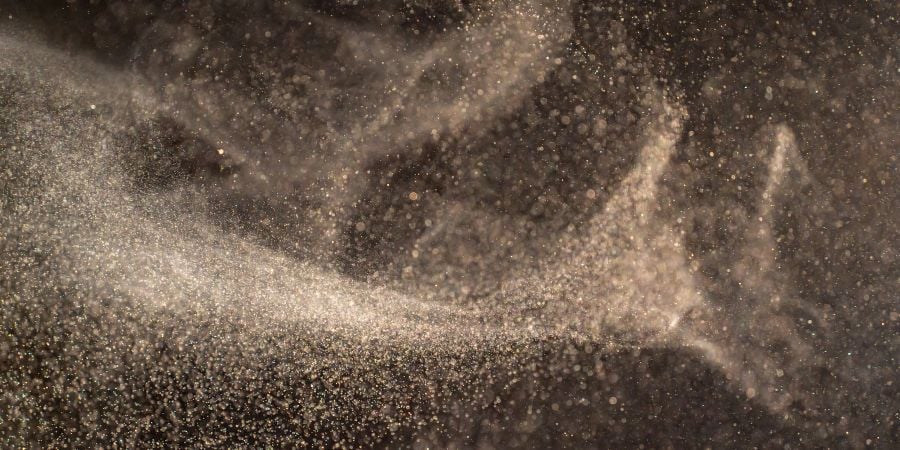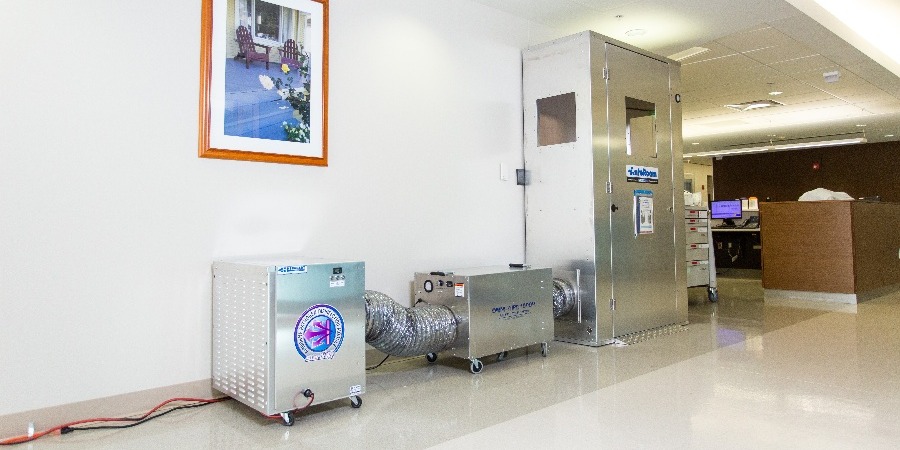Share this
How to Triumph Over the Invisible Threat of Airborne Particles
by HEPACART on Nov 20, 2023

Infection control is difficult enough in a healthcare setting with a constant flow of new people — and the germs they bring — mixed with sensitive patient populations and many staff members coming in and out of patient rooms. To make things even more complicated, we aren’t just worried about physical contact and contaminated surfaces when it comes to high levels of infection control. There’s an entirely separate, more sinister way that infection can be transferred from person to person — airborne particles.
Modern hospitals and medical centers must find ways to mitigate the risks of airborne particles. However, doing so in a practical and manageable way that doesn’t get in the way of critical healthcare tasks can be incredibly challenging. Does this sound familiar? If so, you’re not alone. In today’s blog, we’re diving into four practical ways to control and destroy airborne disease-causing pathogens and empower your facility to stay as healthy and safe as possible.
Start With Proven HEPA Filtration
First things first — the obvious place to start is with high-efficiency air filtration that can remove airborne particles from the air in your facility. But how can you be confident that your filter of choice is actually providing the level of filtration that you’re looking for? The answer is clear. High-efficiency particulate air, or HEPA, filters are your best solution.
The standard “true” HEPA filter is rigorously tested and certified to reliably filter out 99.97% of particles down to 0.3 microns in size. These can also be categorized as H10, H11, or H12 filters. You’ll most often find this level of HEPA filtration built into systems such as household air purifiers, HVAC systems, cars, and even some vacuum cleaners.
While standard HEPA filters are sufficient for many applications, you may want to consider medical-grade HEPA filters that into the H13 or H14 category for your facility’s infection control strategy. Medical-grade HEPA filters provide a more advanced level of filtration and are able to capture 99.97% of airborne particles down to 0.03 microns in size, like those that potentially carry disease. Some advanced filtration systems also integrate UV-C light technology, providing an additional disinfection layer and further enhancing a HEPA filter’s effectiveness. When you combine the power of UV-C light with a medical-grade H13 or H14 filter, you’re able to maximize your defense against potentially harmful airborne particles.
Combating Invisible Dangerous Particles
Did you know that something as simple as dust from construction activities in your facility could be dangerous? Exposure to toxic substances in a healthcare setting can happen through inhalation, absorption through the skin, or ingestion, but dust created by construction activities can be particularly harmful. Even with that said, it’s entirely possible to limit the impact of debris launched into the air from construction projects with strategic planning and innovative equipment.
4 Ways to Fight Airborne Contamination

Every facility must undergo renovation or construction activities at one time or another. Still, the good news is that your facility can take plenty of practical steps to proactively prevent contamination through airborne particles.
1. Dust Containment
The battle against airborne contamination starts with keeping the dust in check. Employ dust containment carts for small maintenance activities, placing them near openings in ceilings and walls. For entire rooms, use anterooms to seal off entrances and keep dust contained. Barrier wall systems are also useful for large-scale construction areas.
2. Airflow Management
Employ a negative air machine, and ensure it has the adequate capacity for the required Air Changes Per Hour (ACH) in your hospital setting. The standard requirement is between 6 and 12 times per hour. This measurement helps to maintain a constant air turnover and keeps the environment safe.
3. HEPA Filtration
Superior HEPA filtration is essential in environments with vulnerable patients like infants, the elderly, or the immunocompromised, as it drastically reduces the risk of healthcare-associated infections (HAIs) caused by spores of environmental fungi. Whether you opt for standard or medical-grade HEPA filtration, you can confidently expect high safety and indoor air quality (IAQ). Without excellent filtration as a part of your infection control strategy, it becomes much more difficult to combat the spread of these types of airborne contaminants.
4. Far-UV Sterilization
For decades, scientists have understood the germicidal properties of short-wavelength ultraviolet (UV-C) light, which effectively kills bacteria and inactivates viruses. However, using ordinary UV-C light comes with significant health risks, such as the potential to cause skin cancer and cataracts, making it unsuitable for disinfection in public spaces. This is where Far-UV-C light offers a promising alternative. Unlike its conventional counterpart, Far-UV-C light operates at a specific wavelength range within the UV-C spectrum that is unable to penetrate the dead outer layer of human skin or the outer tear layer of the eye, making it a much safer and more practical alternative for disinfection. Additionally, the higher photon energy of Far-UV-C light makes it even more effective at destroying pathogens.
4 Ways to Destroy Airborne Pathogens

1. Ventilation
When it comes to improving indoor air quality, bringing fresh air from the outside into a building is the gold standard. Provided that the outside air is actually clean, introducing it into the building can significantly reduce the concentration of contaminants, including airborne pathogens. This method becomes more effective the more that you do it, so don’t be afraid to air out spaces in your facility on a beautiful day.
2. Air Distribution
If you're serious about minimizing the risk of airborne pathogens, you'll need to include an HVAC expert on your team. Collaborating with medical staff who understand the characteristics of the primary pathogens — how they are emitted, how they survive, and how they are transmitted between hosts — the HVAC expert can help your facility make the most informed decisions possible. This includes choosing the best location, direction, and velocity of air outlets to minimize cross-infection. They can also provide direction to adjust temperature and humidity settings in the facility to create an environment where viruses find it hard to survive.
3. Air Filtration
For even more control over airborne pathogens, managing air pressure in specific zones is critical. What does this look like? Specialized equipment, like our HEPAFORCE® Negative Air Machines, can be used to isolate areas such as patient rooms. Maintaining a slightly lower air pressure in these zones prevents airborne particles from escaping when someone enters or exits the room or through other potential leaks in the space.
4. Air Disinfection
Germicidal ultraviolet radiation, which has been in use for over a century, can effectively deactivate airborne pathogens and make your facility safer. Conventional UV-C radiation has a broad range of uses, including air and water disinfection, wastewater treatment, and sterilizing surfaces and equipment. However, technologies like Far-UV-C offer a safer and potentially more effective alternative for air disinfection, as they can neutralize pathogens without posing the same health risks associated with traditional UV-C light.
Your Roadmap to Safer, Cleaner Air
Navigating the complexities of airborne pathogen control in a healthcare facility is no small feat, but you're far from navigating it alone. Today, we've outlined actionable strategies — ranging from improving ventilation to employing advanced technologies like Far-UV-C light — that can significantly bolster the safety of your facility.
Are you ready to dive deeper? We have a comprehensive guide ready for you to download. It provides step-by-step instructions to ensure you make the most informed decisions possible for airborne pathogen control.

